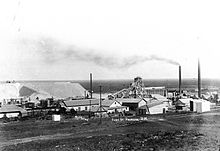
Moorabbin Airport is a mostly general aviation airport for light aircraft located in between the southern Melbourne suburbs of Heatherton, Cheltenham, Dingley Village and Mentone. It also receives commercial airline service. The airport grounds are treated as their own suburb, and share the postcode 3194 with the neighboring suburb of Mentone. With a total of 274,082 aircraft movements, Moorabbin Airport was the second busiest airport in Australia for the calendar year 2011.
An uncontrolled decompression is an undesired drop in the pressure of a sealed system, such as an aircraft cabin or hyperbaric chamber, that typically results from human error, structural failure, or impact, causing the pressurised vessel to vent into its surroundings or fail to pressurize at all.
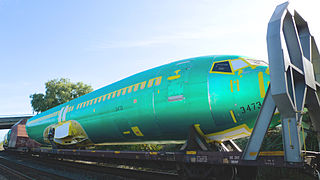
Cabin pressurization is a process in which conditioned air is pumped into the cabin of an aircraft or spacecraft in order to create a safe and comfortable environment for humans flying at high altitudes. For aircraft, this air is usually bled off from the gas turbine engines at the compressor stage, and for spacecraft, it is carried in high-pressure, often cryogenic, tanks. The air is cooled, humidified, and mixed with recirculated air by one or more environmental control systems before it is distributed to the cabin.

The Beechcraft 1900 is a twin-engine turboprop regional airliner manufactured by Beechcraft. It is also used as a freight aircraft and corporate transport, and by several governmental and military organizations. With customers favoring larger regional jets, Raytheon ended production in October 2002.

Helios Airways Flight 522 was a scheduled passenger flight from Larnaca, Cyprus, to Prague, Czech Republic, with a stopover in Athens, Greece. Shortly after take-off on 14 August 2005, air traffic control (ATC) lost contact with the aircraft operating the flight, named Olympia; it eventually crashed near Grammatiko, Greece, killing all 121 passengers and crew on board. It is the deadliest aviation accident in Greek history.

Connellan Airways was an airline headquartered in Alice Springs, Australia. It operated scheduled flights as well other air transport services throughout the Northern Territory from 1939 to 1980.
Transair was an airline based in Australia. The Civil Aviation Safety Authority cancelled the Air Operator's Certificate, at the request of Transair, on 4 December 2006. Transair ceased all operations from that date. This action followed investigations by the Civil Aviation Safety Authority and Australian Transport Safety Bureau into the airline's safety after the fatal accident of one of Transair's aircraft on 7 May 2005.

On October 25, 1999, a chartered Learjet 35 business jet was scheduled to fly from Orlando, Florida, United States to Dallas, Texas, United States. Early in the flight, the aircraft, which was climbing to its assigned altitude on autopilot, lost cabin pressure, and all six on board were incapacitated by hypoxia, a lack of oxygen in the brain and body. The aircraft continued climbing past its assigned altitude, then failed to make the westward turn toward Dallas over North Florida and continued on its northwestern course, flying over the southern and midwestern United States for almost four hours and 1,500 miles (2,400 km). The plane ran out of fuel over South Dakota and crashed into a field near Aberdeen after an uncontrolled descent.

Aircraft emergency oxygen systems or air masks are emergency equipment fitted to pressurized commercial aircraft, intended for use when the cabin pressurisation system has failed and the cabin altitude has climbed above a safe level. It consists of a number of individual yellow oxygen masks stored in compartments near passenger seats and near areas like lavatories and galleys, and an oxygen source, like a centralized gaseous cylinder or decentralized chemical oxygen generator.

Qantas Flight 30, on 25 July 2008, a Boeing 747-438 operated by Qantas, construction number 25067, registration VH-OJK, was a scheduled flight from London Heathrow to Melbourne with a stopover in Hong Kong. The flight was interrupted on the Hong Kong leg by an exploding oxygen tank that ruptured the fuselage just forward of the starboard wing root. 53-year-old Captain John Bartels and his co-pilots, Bernd Werninghaus and Paul Tabac, made an emergency descent to a breathable altitude of about 10,000 feet and diverted to Ninoy Aquino International Airport, Metro Manila, Philippines. There were no injuries.

Qantas Flight 72 (QF72) was a scheduled flight from Singapore Changi Airport to Perth Airport by an Airbus A330. On 7 October 2008, the flight made an emergency landing at Learmonth Airport near the town of Exmouth, Western Australia, following an inflight accident that included a pair of sudden, uncommanded pitch-down manoeuvres that caused severe injuries—including fractures, lacerations and spinal injuries—to several of the passengers and crew. At Learmonth, the plane was met by the Royal Flying Doctor Service of Australia and CareFlight. Fourteen people were airlifted to Perth for hospitalisation, with 39 others also attending hospital. In all, one crew member and 11 passengers suffered serious injuries, while eight crew and 99 passengers suffered minor injuries. The Australian Transport Safety Bureau (ATSB) investigation found a fault with one of the aircraft's three air data inertial reference units (ADIRUs) and a previously unknown software design limitation of the Airbus A330's fly-by-wire flight control primary computer (FCPC).
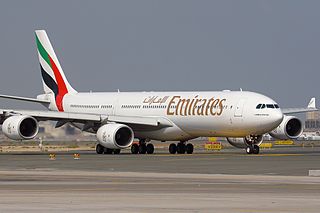
Emirates Flight 407 was a scheduled international passenger flight operated by Emirates from Auckland to Dubai with a stopover in Melbourne, operated by an Airbus A340-500 aircraft. On 20 March 2009, the flight failed to take off properly at Melbourne Airport, hitting several structures at the end of the runway before climbing and then returning to the airport for a safe landing. Although no fatalities or injuries resulted, damage to the aircraft was severe enough for the event to be classified by Australian Transport Safety Bureau as an "accident". It was subsequently determined that a data-entry error resulted in insufficient engine thrust during take off. It has been described "as close as we have ever come to a major aviation catastrophe in Australia" by aviation officials.
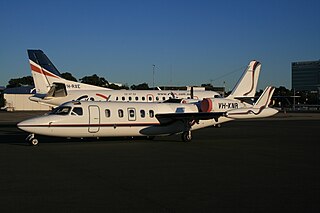
The 2009 Pel-Air Westwind ditching or Norfolk Island ditching was an aircraft accident on 18 November 2009 near Norfolk Island, Australia. A Westwind II jet operated by Pel-Air was conducting an air ambulance flight for CareFlight International when it was forced to ditch after being unable to land in bad weather and not having sufficient fuel to divert to an alternate destination.

On 22 September 1966 a Vickers Viscount departed from Mount Isa, Queensland, Australia for a 73-minute flight to Longreach. Forty-four minutes after takeoff a fire started in one of the engines. The crew were unable to extinguish the fire or feather the propeller so made an emergency descent with the intention of landing at Winton, a small town along the route. The fire spread to the fuel tank and weakened the wing structure so that a large part of the left wing broke away and the aircraft crashed. All twenty-four occupants were killed. The accident remains the fifth-worst in Australia's civil aviation history.

On 1 October 2012, Riama, a 1934 vintage de Havilland DH.84 Dragon passenger aircraft, crashed in Queensland, Australia, while flying from Monto to Caboolture. Radio contact was lost about an hour after the pilot reported to be in cloud with zero visibility. The wreckage was found in heavily wooded, hilly terrain two days later. The pilot and five passengers were killed in the accident.

Whyalla Airlines Flight 904 was a scheduled commuter flight, operated by a Piper PA-31 Navajo which crashed while attempting to ditch in the Spencer Gulf, South Australia after suffering failures of both engines on the evening of 31 May 2000. All 8 people on board the aircraft were killed as a result of the accident. The findings of a subsequent investigation by the Australian Transport Safety Bureau highlighting the airline's operating procedures as a key factor leading to the accident were later overturned after they were contradicted by evidence presented at a coronial inquiry into the deaths of those on board the flight. The safety implications arising from the accident were subject to a recall by engine manufacturer Textron Lycoming which saw close to 1000 aircraft grounded worldwide while defects were rectified at an estimated cost of $A66 million. Australia's aviation regulator, the Civil Aviation Safety Authority also mandated lifejackets be carried on all aircraft operating over water after the crash.

On 21 February 2017, at 8:59 am local time, a Beechcraft B200 King Air aircraft operating a charter flight, carrying a pilot and four passengers bound for King Island, crashed seconds after taking off from Essendon Airport in Melbourne, Australia.

On 31 December 2017 at about 3:15 pm AEDT (UTC+11:00), a de Havilland Canada DHC-2 Beaver configured as a floatplane crashed into Jerusalem Bay off Cowan Creek, on the northern outskirts of Sydney, Australia. The aircraft, operated by Sydney Seaplanes, was carrying five passengers and a pilot, all of whom were killed in the crash. It was returning diners from Cottage Point Inn restaurant to Rose Bay Water Airport. The ATSB believes it probable that the pilot's performance was adversely affected by carbon monoxide poisoning. Post mortem tests on the bodies of the victims showed raised levels of CO in the blood, and a crack in the exhaust system was seen as the likely source of the gas.
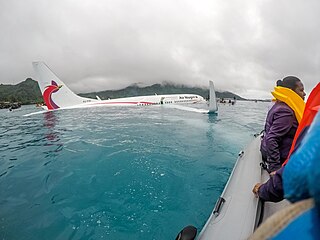
Air Niugini Flight 73 was a scheduled service from Pohnpei, Federated States of Micronesia (FSM) to Port Moresby, Papua New Guinea, via Chuuk, FSM. On 28 September 2018, a Boeing 737, operated by Air Niugini, landed short of the runway at Chuuk International Airport in Weno (FSM) and came to rest in Chuuk Lagoon. Locals in small boats rescued most passengers and all crew members. One passenger was initially declared missing. He was later found dead by rescue divers. Forty-six people survived but six of them were injured.

The 1994 South Pacific Airmotive DC-3 crash took place on 24 April 1994, when a Douglas DC-3 airliner operated by South Pacific Airmotive, tail number VH-EDC, ditched into Botany Bay shortly after takeoff from Sydney Airport in Sydney, New South Wales, Australia. The cause of the crash was determined by the Bureau of Air Safety Investigation to have been a power loss in the aircraft's left engine caused by an inlet valve being stuck in the open position, compounded by inadequate action on the part of the pilots; Rod Lovell, the pilot in command of the flight, has disputed BASI's conclusions.

